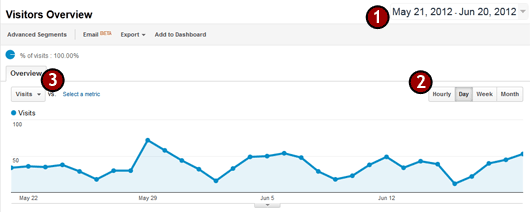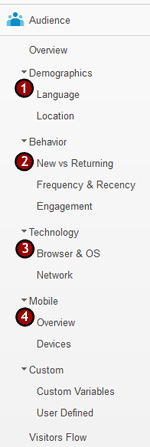The Beginner’s Guide to Google Analytics Part 1: Overview and Audience
This series of articles is intended to help you understand what the numbers in Google Analytics mean and which are typically important for marketing professionals. If you log into your Google Analytics account and aren’t even sure where to begin, these articles should help point you in the right direction.
Overview Screen
This is the first screen that you see. The primary settings that you should know are numbered in the screenshot below:
- Date Range: You can view and change the range of dates that you’re viewing here. You can also compare two different date ranges.
- Datapoint Specificity: Here, you can determine how detailed you want the graph to be.
- Metric: Choose which metric(s) you want to show on the graph.

On this screen, I will often set the date range to show the entire time the site has been live, and set the datapoint specificity to “month.” This provides a good overview of traffic for the entire time Analytics has been installed. Another interesting thing to do is to use the date range selector to compare two months or years.
Definitions of the Terms
Throughout the Analytics reports, there are frequently used terms that I’ve defined below. One general note: all the numbers on these reports should be considered estimates due to the imprecise nature of website tracking. Because of this, it’s better to compare these numbers in relation to each other, rather than taking them too literally.
- Visits: The number of times users have visited your site. If a user is inactive or leaves the site for more than 30 minutes before returning, it will count as a new session.
- Unique Visitors: Unlike with visits, this only counts each person once. However, if a person uses a different computer or browser, they may be counted more than that.
- Pageviews: The total number of pages that were viewed combining all visits from all visitors.
- Pages / Visit: This is the average number of pages viewed during each visit.
- Avg. Visit Duration: This is the average length of time a visitor spends on your site.
- Bounce Rate: The percentage of single-page visits (i.e. visits in which the person left your site from the same page that they entered). If this number is high, it means that people aren’t viewing multiple pages on your site, which might be a problem.
- % New Visits: This is the percentage of visits by people who have never been to the site before.
There are more definitions on this page, if you don’t find what you’re looking for above.

Key Audience Reports
- Demographics: The two reports in this section cover the location and language of your visitors. This can be good for marketers to help determine how to target offline advertising geographically, or whether they should invest in a translated version of their website.
- Behavior: These three reports show information about your visitor’s habits. Knowing whether your site has more returning visitors or new visitors can help you make decisions about how to structure your site. For instance, do you need a basic introduction to your company on every page, or do your visitors mostly know who you are? The other two reports show how often people visit and how many pages they view when they do visit.
- Technology: This is probably most useful when developing new features for your website. Do you still need to support certain browsers? What screen resolutions are most common? Under the Browser & OS page, don’t overlook the additional reports. Even though it defaults to “Browser”, there are separate reports for OS, screen resolution, and Flash support.
- Mobile: This section gives you information on your mobile visitors, which can help you decide if you should invest in improving the mobile experience of your site. One thing to note, however, is that this number includes the iPad and Android tablets. I usually filter those out (at least the iPad), to get a better idea of truly small-screen devices.
In the next article, I’ll discuss the Advertising and Traffic Sources sections of Google Analytics.